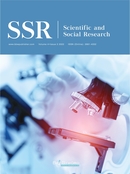An Acoustic Community: Soundscapes and Community Building in The Sound and the Fury
Abstract
Among the thematic researches on the late William Faulkner, the auditory exploitation of various points has been on the forefront of attention and increasingly generative. In delving into the question of hearing of, Sarah Gleeson-White and John T. Mathews have respectively tapped into the auditory experiments in Absalom, Absalom! and As I Lay Dying. The distinct Faulknerian sonic qualities, however, could actually be pushed back to The Sound and the Fury. Hearkened to properly combine the acoustic that could be built upon the orchestration of the sounds from the previous cacophony. Based on the overall acoustic, an inclusive community is built.
References
White SG, 2013, Faulkner, Eisenstein, and Film Sound. PLMA, 2013(1): 87-100.
Matthews JT, 1985, Faulkner and the Reproduction of History, in Gresset M, Coy J, Faulkner and History, University of Salamanca Press, Salamanca, 67.
Shakespeare W, 1997, Macbeth [Braunmuller AR, Eds.], Cambridge University Press, Cambridge, 229.
Schafer RM, 1977, The Soundscape: Our Sonic Environment and the Tuning of the World, Knopf, New York, 9-10, 215.
Tonnies F, 2001, Community and Civil Society. Trans. Jose Harris and Margaret Hollis, Cambridge University Press, Cambridge, 19.
Faulkner W, 1984, The Sound and the Fury, Random House, New York, 8-309.
McLuhan T-M, 1962, The Gutenberg Galaxy, Toronto, 32.
Yuan X-P, 2016, Criticism and Research on William Faulkner, Southest Jiaotong University Press, Chengdu.
Ross SM, 1989, Fiction’s Inexhaustible Voice: Speech and Writing in Faulkner, University of Georgia Press, Athens.
Wall JL, 2017, Sound and Fury: Accent and Identity in Faulkner’s Immigration Novel. MELUS, 42(1): 94-115.

